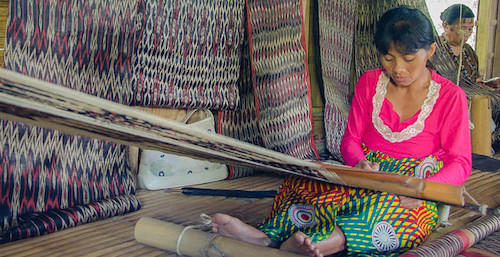Blog: From Local to Global – Questions SMEs Should Answer Before Exporting
Tuesday, June 12, 2018


By Dan DeValve
The decision by small and medium enterprises (SMEs) in emerging economies to enter an international market is a key step in their maturation. For some SMEs, the move is necessary for survival in a competitive local economy, while for others it’s a logical next step for a successful and growing organization.
Kim Ian’s Dairy Delights is an excellent example of how a locally successful business in an emerging economy, in this case, the Philippines, approaches the decision to transition to the regional or international market. In 2015, I traveled to the Philippines and visited the town of Los Baños, home to many agribusinesses and located near the capital city of Manila. One of the town’s successful small businesses, Kim Ian’s Dairy Delights, had rapidly grown its production of goat milk-based cream cheese. It now faced a decision between scaling up the business to reach supermarket chains in Manila, or remaining in the much smaller niche market in Los Baños. The business owner recognized that expansion of the business would require reallocation of resources to pay for marketing and logistics, significant financial investment and risk, and a strategy for healthy growth of the company. Despite the risks, ultimately the namesake owner decided that their success hinged on a transition to the larger Manila market.
“Foreign market entry is considered as a key strategy to grow and survive over longer periods of time for SMEs,” according to a recent study on Bangladeshi SMEs in the International Marketing Review. In emerging economies with vibrant entrepreneurship sectors, such as the Philippines, the decisions made by these business leaders are instructive and can be illuminating for SMEs in other emerging economies.
THE BENEFITS AND RISKS OF EXPORT MARKETS
While entering the export market has clear benefits, it is a major risk for a small business and can easily result in failure. As key factors of success, a recent study in the Journal of World Business stressed the importance of international business experience on the part of the SME owner, the strength of the home country’s institutional support for SMEs, and whether the SME is using the proper business model. If they have the advantage of institutional support, such as the local government or a business incubator, business owners can also utilize a “learning-by-exporting” model to make the transition, as highlighted in a previous NextBillion post.
A selection of three recent case studies published by WDI Publishing, part of the William Davidson Institute, highlights several issues commonly faced by Philippine SME owners as they consider a move to the international market. These three cases, which are available for free, were among a total of 94 published as part of a four-year project focused on training university faculty in the Philippines on how to teach and write business case studies. WDI implemented the project, in partnership with RTI International and the United States Agency for International Development (USAID).
THREE CASE STUDIES EXPLORING EXPORT CHALLENGES
A business case study is a documented analysis of a real-life business scenario, typically one in which the protagonist must make a crucial decision affecting the success of the business. As a teaching tool, cases provide students with “real-life” experience in decision-making and strategic thinking. As Philippine faculty engaged with a local business and identified a dilemma to feature in their cases, we noticed many focused on whether or not SMEs in the Philippines should enter international markets.
- In Weaving the Magic Wand for the IPMC Weavers, the chair of the Indag-an Primary Multi-Purpose Cooperative (IPMC), is eyeing export of its popular hablon (hand-woven textiles). Her challenge is deciding how to adjust the cooperative’s existing business model and improve the efficiency of her supply chain to maximize market opportunities at both the local and international levels. Fortunately, because the hablon is traditional weaving, the local government is interested in supporting the cooperative to attract tourists to the region and provides additional training for weavers, marketing of products outside the Iloilo region, and storage facilities for the finished product. IPMC’s chair knows she can rely on this government support as she makes her decision.
- In Green Fields Coco Products (GFCP), the business produces virgin coconut oil (VCO) and sells it throughout the Philippines. While it was one of the original entrants into the growing VCO market, GFCP is facing increasing competition and the owner must decide between exporting the product or making significant changes to continue to compete in the domestic market. The owner has ambitions to enter Asian and American markets, but isn’t sure if the move is wise because he lacks the marketing budget and production capacity.
- In REFMAD-V Enterprise, the business owner operates a dragon-fruit farm in the Ilocos Norte region and has been steadily increasing production capacity for several years. She was approached by a group of international businessmen interested in importing several of her products to Canada. The company also benefits from institutional support from the local arm of the Department of Trade and Industry in the form of free promotion and advertising. The case study asks students to evaluate whether exporting is right for the company, as well as whether her company could meet the increased demand.
A common theme runs across these three cases. Each business is established in the domestic market with varying degrees of success, and each owner recognizes the advantages to be gained in exporting. Despite the potential benefits, the business owners must also consider the risks, especially adjusting an existing business model and scaling up production capacity to meet the demands of a new market.
ASSESSING THE RESULTS
Because the case studies were published in 2016 and 2017, WDI was able to review the various decisions ultimately made by these business owners and the ensuing results:
- Following the publication of the case study, IPMC continued to receive support from the local government as a producer of traditional weaving. The cooperative was able to market its products in the Southeast Asia region on a small scale, but continues to sell primarily within the Philippines, including an increased investment in marketing to tourists.
- GFCP, despite recognizing the advantages of entering the international market, was not able to allocate the necessary resources to make the transition, and did not export its products. The business was also unable to adapt to increased domestic competition and as a result, it ended up closing.
- REFMAD-V Enterprises has been extremely successful and is now one of the largest dragon-fruit producers in the Philippines. The business started exporting to Canada, but the domestic market is still the primary focus. REFMAD also invested in rebranding and, in addition to growing dragon fruit, it has become a top destination for agritourism.
As this view inside three organizations showcases, SME owners can find it difficult to make the transition from domestic to international markets due to a lack of business experience. However, as illustrated in the cases of IPMC and REFMAD, government support for SMEs during this process is crucial. It can include assistance, such as the coordinating of trade fairs to help business owners make new connections, entrepreneurship training programs to provide business owners with the tools needed to scale a business, or even simple promotion of the business to potential customers.
As in the case of GFCP, if the business expertise, proper business model and ability to scale up production are absent, and the business has little to no external support, the idea of entering the international market remains only a dream.
Note: This article was written by Daniel DeValve, a senior project manager for grants management at WDI. The article originally appeared on NextBillion, which is managed by WDI.
Photo by I Travel Philippines via Flickr
